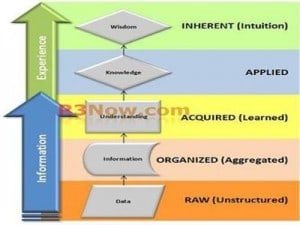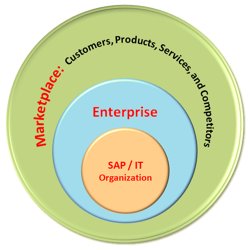
This post is a continuation of Business Transformation for IT Leadership and is part of a journey around Organizational Change Management Inside the IT Support Organization.
To achieve an active, vibrant, knowledge-sharing learning organization, you need some baseline understanding of what your goals are. You need a culture that produces, organizes, disseminates, applies, and then refines information (see the image to the left).
This leads me to the next key point that few people who call themselves “knowledge managers” have much understanding of: Information management is not knowledge management. However, both information management and knowledge management are critical components of a learning organization.
Information is the vehicle; knowledge is the destination.
What is Knowledge?
Knowledge is the application of information, in a particular context, coupled with experience -– it is not in some system. Information is stored in systems; knowledge is stored in people. ~Bill Wood, 2006.
Creating a Knowledge Centered Learning Organization is Really Exciting! (In the Sales Material)
Many people are excited about the idea and even the prospects of creating a learning organization. Achieving a vibrant learning organization with a knowledge sharing culture can reap huge rewards for a company’s competitive position in the marketplace.
Even the Harvard Business Review has gotten on board and sells a few “knowledge products” of their own. Their pitch suggests that creating a learning organization leads to competitive business advantage. After all, when you have a workforce that learns and applies new knowledge, new techniques, and new methods to addressing the marketplace, you are creating competitive advantage. However, a learning organization is more than a pitch; it can in fact make a significant impact on your business and organization.
A learning organization requires a social component (people), delivery architecture (technology), and a structured method to share information (process). By transforming your SAP/IT Organization into a learning organization, you are taking the first steps to bridge the gap between an enterprise focus and an external market or customer focus.
A learning organization requires motivation.
The Wheels Fell Off My Learning Organization Bus
You are excited about the possibilities, so you announce your thoughts to your leadership. You can hear a pin drop. Except for the possible brown noser, no one is jumping on your bus. But why should they? Your idea sounds like another fad, another task, something else to monitor. To them, you are talking about one of their worst fears and frustrations: While you are thinking about dynamic cultural transformation, they are hearing social media management and more work. Your managers may be thinking, “Have you lost your mind? How do I manage all this social media stuff when I have to meet my other goals?”
Get the Employees on the Bus First
Before you start promoting the idea of creating a learning organization, you need to plan how to do so in manageable and incremental steps. You need to ensure the key resources are on the bus before you try to make the trip. In other words, you need to bring the broader business community to a more accepting posture for your SAP/IT organizational changes by using Change Management Strategies and Knowledge Transfer Processes for a Successful SAP Project 1.
Lasting Change Begins at Home.
As part of a three-tier process for transforming your SAP or IT support organization, you might begin with Change Management Strategies and Knowledge Transfer Processes for a Successful SAP Project 2, so the business gains greater application maturity. Equally, you must address How To Steps in the SAP Business Transformation Journey within your SAP IT organization.
The Right Information, Right Now
The goal for the first phase is the right information right now within the SAP/IT Organization. After the internal IT support organization is immersed in information sharing, it can then be rolled out systematically to the other two key areas of the Enterprise, and finally to the broader marketplace.
Build the infrastructure to support a learning organization first.

This collaboration approach is the first step to ERP III – Is the Integration of Collaboration the Future of Enterprise Applications. The three key phases to this organizational transformation include the following:
- Make use of collaboration and social media tools within the organization,
- Deploy both push and pull information tools to leverage information resources, and
- Create an internal employee skills base (think of an internal LinkedIn).
Once the information sharing infrastructure is in place, you can focus on creating an information consuming culture within your SAP or IT organization. In other words, build the infrastructure to support a learning organization first.
High-Level Steps to Build a Knowledge-Based Learning Organization
- Build out the push/pull information infrastructure.
- Make participation part of the goals/review/bonus structure.
- Pilot the structure inside the IT organization.
- Roll out to the entire IT organization.
- Scale up and modify the push/pull infrastructure.
- Pilot the structure within a BU or business organization (i.e. begin to converge IT and the business).
- Capture lessons learned and adjust; then roll out to the broader business community.
- Repeat the steps to roll out to the customer base.
- Repeat the steps to roll out to broader (possibly targeted) market segments.





